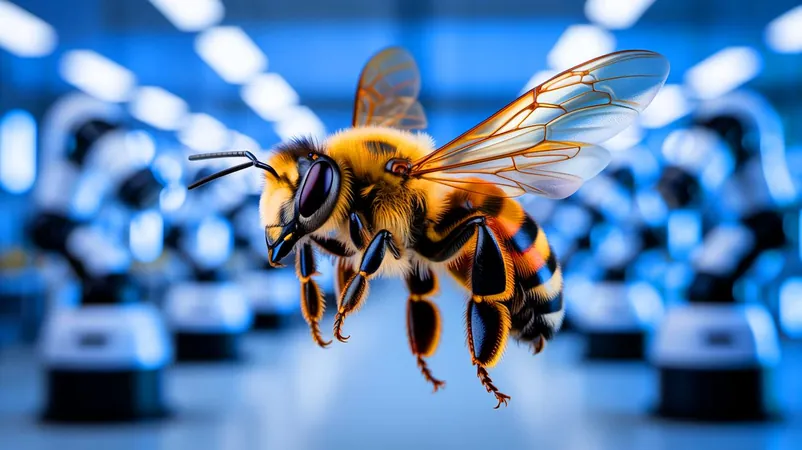
Unlocking Nature's Secrets: How Bees Could Transform AI and Robotics Forever
2025-07-04
Author: Kai
Bees: The Unexpected Innovators of AI
In the captivating world of artificial intelligence (AI) and robotics, nature often serves as the ultimate teacher. A groundbreaking study reveals how the mesmerizing behavior of bees—whose tiny brains are no larger than a sesame seed—could inspire revolutionary advancements in technology. Researchers at the University of Sheffield have discovered that bees adeptly shape their visual perception through their unique flight patterns, offering vital clues that could redefine our understanding of AI and pattern recognition.
Bees' Dance: The Key to Advanced Visual Processing
Forget what you know about cognitive abilities based on brain size! Scientists have unveiled that bees use their flight movements to enhance their visual perception actively, allowing them to decipher complex images, from colorful flowers to even human faces. This dynamic interaction showcases their remarkable capacity for visual recognition. By creating computational models that emulate these behaviors, researchers are paving the way for more efficient and intelligent AI systems. This discovery challenges longstanding beliefs about intelligence and opens doors to new technological horizons.
Revolutionizing Robotics: What Bees Teach Us About Efficiency
Professor James Marshall from the University of Sheffield insists that this research illuminates the potential of compact biological systems to execute sophisticated tasks. The ramifications for robotics are impressive; by mirroring these natural cognitive processes, engineers can design robots that process information more like living organisms. Imagine robots that adapt to their environment in real-time—this could soon be a reality!
Rethinking Intelligence: Size Doesn’t Matter!
The traditional belief that a larger brain equals higher intelligence is being overturned. Studies, including groundbreaking work at the University of London, reveal that bees actually require a minimal number of neurons for complex tasks. This finding accentuates that intelligence stems from optimized neural computation rather than sheer size, shifting the focus on AI development toward efficiency. Collaborations, such as those with Queen Mary University of London, showcase how nature's wisdom can lead to advanced technological innovations.
Agricultural Revolution: Robotic Bees to the Rescue!
Inspired by the agility and precision of bees, researchers at MIT are crafting tiny robotic insects designed for agriculture. These remarkable creations, lighter than a paperclip, perform complex aerial maneuvers to assist in artificial pollination. Picture a world where agricultural outputs increase significantly while reducing environmental harm—this is the promise of robotic pollinators as they handle precise pollination tasks in innovative farming environments.
The AI and Robotics Horizon: A New Era in Intelligent Systems
As we glean insights from bee cognition, the future of AI and robotics takes on exciting new shapes. By harnessing the efficiency of bees in processing information, researchers can create intelligent systems that not only replicate human-like capabilities but excel in their adaptability. This revolutionary approach emphasizes the invaluable role of interdisciplinary research in merging biological intelligence with technological advancement.
Embracing Nature's Lessons: The Path Ahead
As we step into a future intertwined with artificial intelligence, one pressing question lingers: how can we further leverage the principles of nature to inspire transformative technologies? The exploration of natural intelligence will undoubtedly yield machines that are not only smarter but also seamlessly connected to their environments, enriching both our technological landscape and everyday lives.




 Brasil (PT)
Brasil (PT)
 Canada (EN)
Canada (EN)
 Chile (ES)
Chile (ES)
 Česko (CS)
Česko (CS)
 대한민국 (KO)
대한민국 (KO)
 España (ES)
España (ES)
 France (FR)
France (FR)
 Hong Kong (EN)
Hong Kong (EN)
 Italia (IT)
Italia (IT)
 日本 (JA)
日本 (JA)
 Magyarország (HU)
Magyarország (HU)
 Norge (NO)
Norge (NO)
 Polska (PL)
Polska (PL)
 Schweiz (DE)
Schweiz (DE)
 Singapore (EN)
Singapore (EN)
 Sverige (SV)
Sverige (SV)
 Suomi (FI)
Suomi (FI)
 Türkiye (TR)
Türkiye (TR)
 الإمارات العربية المتحدة (AR)
الإمارات العربية المتحدة (AR)